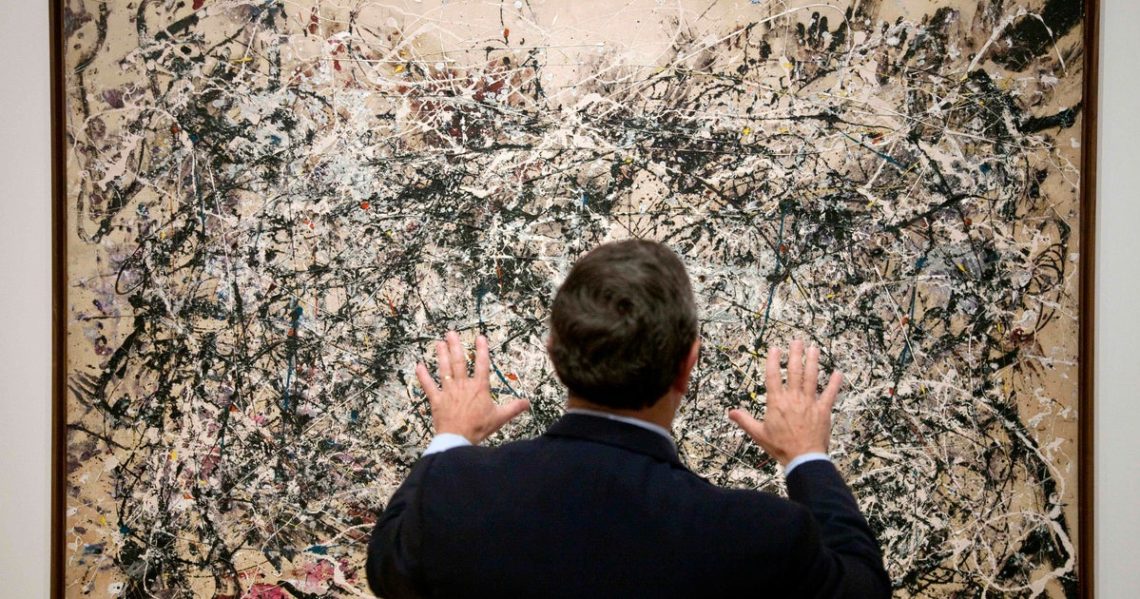Updated on: September 16, 2025 / 6:31 AM EDT
/ CBS/AP
Scientists have identified the origins of the blue color in one of Jackson Pollock’s paintings with a little help from chemistry, confirming for the first time that the abstract expressionist used a vibrant, synthetic pigment known as manganese blue.
“Number 1A, 1948,” showcases Pollock’s classic style: paint has been dripped and splattered across the canvas, creating a vivid, multicolored work. Pollock even gave the piece a personal touch, adding his handprints near the top.
The painting, currently on display at the Museum of Modern Art in New York, is almost 9 feet wide. Scientists had previously characterized the reds and yellows splattered across the canvas, but the source of the rich turquoise blue proved elusive.
In a new study, researchers took scrapings of the blue paint and used lasers to scatter light and measure how the paint’s molecules vibrated. That gave them a unique chemical fingerprint for the color, which they pinpointed as manganese blue.
The analysis, published Monday in the journal Proceedings of the National Academy of Sciences, is the first confirmed evidence of Pollock using this specific blue.
“It’s really interesting to understand where some striking color comes from on a molecular level,” said study co-author Edward Solomon with Stanford University.
The pigment manganese blue was once used by artists, as well as to color the cement for swimming pools. It was phased out by the 1990s because of environmental concerns.
Previous research had suggested that the turquoise from the painting could indeed be this color, but the new study confirms it using samples from the canvas, said Rutgers University’s Gene Hall, who has studied Pollock’s paintings and was not involved with the discovery.
“I’m pretty convinced that it could be manganese blue,” Hall said.
The researchers also went one step further, inspecting the pigment’s chemical structure to understand how it produces such a vibrant shade.
Scientists study the chemical makeup of art supplies to conserve old paintings and catch counterfeits. They can take more specific samples from Pollock’s paintings since he often poured directly onto the canvas instead of mixing paints on a palette beforehand.
To solve this artistic mystery, researchers explored the paint using various scientific tools – similarly to how Pollock would alternate his own methods, dripping paint using a stick or using it straight from the can.
In the study, researchers call the artwork “a quintessential example of his action painting technique where ropes of color, drips of black, and pools of white coalesce into the layered dynamism that defines his style.” While the artist’s work may seem chaotic, Pollock rejected that interpretation. He saw his work as methodical, said study co-author Abed Haddad, an assistant conservation scientist at the Museum of Modern Art.
“I actually see a lot of similarities between the way that we worked and the way that Jackson Pollock worked on the painting,” Haddad said.
Artwork by Pollock, who became a sensation on the New York art scene in the 1940s, has popped up in unusual places over the years.
In 2023, authorities in Bulgaria said a painting seized by police during a raid was likely a little-known work by the artist.
In 2017, a painting found in a garage in Arizona was believed to be a Pollock artwork worth $15 million.
The post Color mystery in famous Jackson Pollock painting finally solved appeared first on CBS News.




